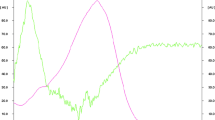Abstract
Sitopaladi churna is one of the Ayurvedic remedies for the treatment of cough, bronchial problems, and congestion in the upper respiratory system. It consists of herbs the Cinnamomum zeylanicum, Elettaria cardamomum, Piper longum, vanshlochan from Bambusa bambos, and cane sugar. A high-performance thin-layer chromatography (HPTLC) method was developed for the quantification of piperine, cinnamaldehyde, and 1,8-cineole. The mobile phase was optimized to achieve proper separation between chromophoric and nonchromophoric chemical markers. The densitometric scanning was done at 307 nm for piperine and cinnamaldehyde and at 599 nm for 1,8-cineole after derivatization with 1% of vanillin‒sulfuric acid. The linearity range was 100–500 ng/band for piperine and cinnamaldehyde and 600–3000 ng/band for 1,8-cineole. The linear regression analysis data show a good linear relationship with correlation coefficient (R) ≥ 0.99 for all three selected chemical markers. The proposed method was fully validated according to analytical method guidelines. The results indicate that the proposed HPTLC method was found to be accurate, simple, and precise and can be used for the quantification of the mentioned markers in sitopaladi churna and other herbal formulations.




Similar content being viewed by others
References
Anonymous (2003) The Ayurvedic Formulary of India, Part-I, second revised English ed. Ministry of Ministry of Health and Family Welfare, Department of Indian Systems of Medicine and Homoeopathy, pp 348–349
Sastri P (2018) Dipika commentary of Adhamalla & Gudhartha dipika of Kasirama on Sarngadhara Samhita of Sharngdhara, Madhyama Khanda, Choorna kalpana: Chapter 6, Verse 1, p 178. Chaukhambha Orientalia, Varanasi
Makhija IK, Aswatha Ram HN, Shreedhara CS, Vijay Kumar S, Devkar R (2011) In vitro antioxidant studies of Sitopaladi churna, a polyherbal Ayurvedic formulation. Free Radic Antioxid 1(2):37–41. https://doi.org/10.5530/ax.2011.2.8
Priyabrata P, Sangram KP, Snehasis D, Manaswini B, Susanta Kumar M (2010) study of anti-tussive activity of Sitopaladi churna: a poly-herbal formulation. Int J Pharm Sci Rev Res 4(2):65–67
Bharti A, Dheeraj A, Alpana R (2008) Antihistaminic effect of Sitopaladi churna extract. Res J Pharm Tech 1(2):89–92
Barde A, Yadav S, Worlikar P, Tilak A, Kumar H, Raveendran S (2017) Study of immunomodulatory effect of sitopaladi churna in mice. IJBAMR 7(1):181–192
Makhija IK, Shreedhara CS, Ram HN (2013) Mast cell stabilization potential of Sitopaladi churna: an ayurvedic formulation. Pharmacogn Res 5(4):306–308. https://doi.org/10.4103/0974-8490.118824
Smitha KP, Kulashekar KS, Pavithra TK, Kumar BSA, Saran GS (2016) Alpha-amylase inhibitory activity of Sitopaladi churna: an Ayurvedic formula. Trad Integr Med 1(1):40–43
Balekundri A, Mannur V (2020) Quality control of the traditional herbs and herbal products: a review. Futur J Pharm Sci 6:67. https://doi.org/10.1186/s43094-020-00091-5
Makhija IK, Shreedhara CS, Ram HH (2012) Physico-chemical standardization of Sitopaladi churna. Anc Sci Life 31(3):107–116. https://doi.org/10.4103/0257-7941.103187
Parida S, Mishra SK (2014) Method of identification and standardisation of ‘Vamsalochana’ (Bamboo Manna). Indian Drugs 51(01):55–58
Vishvnath G, Jain U (2011) Quantitative analysis of piperine in ayurvedic formulation by UV spectrophotometry. Int J Pharm Sci Res 2:58–61
Hazra AK, Chakraborty B, Mitra A, Sur TK (2019) A rapid HPTLC method to estimate piperine in Ayurvedic formulations. J Ayurveda Integr Med 10(4):248–254. https://doi.org/10.1016/j.jaim.2017.07.006
Arun KSP, Umakant S, Karbhal KS, Inchulkar SR, Prashant Kumar G, Arun Kumar M, Chauhan NS (2023) Green HPTLC-method to estimate trans-Cinnamaldehyde in Ayurvedic formulation Sitopaladi churna. Tradit Med Mod Med 6:1–8. https://doi.org/10.1142/S2575900023500064
Patel ND, Prajapati PN, Kanaki NS (2020) Quality assessment of Sitopaladi churna using high-performance liquid chromatography coupled with multivariate analysis. J Chromatogr Sci 58(10):961–968
Vadalia JM, Sanandia J, Sheth N (2020) Comparative quantitative phytochemical and HPTLC analysis of two Euphorbiaceae family plants under the name Dugdhika. J Planar Chromatogr 33:473–479. https://doi.org/10.1007/s00764-020-00059-4
Mishra S, Ramdas GN, Shanker K (2020) HPTLC method for the simultaneous determination of six bioactive terpenoids in Putranjiva roxburghii wall. J Planar Chromatogr 33:353–364. https://doi.org/10.1007/s00764-020-00047-8
Horvath G, Kocsis B, Lemberkovics E, Boszormenyi A, Ott P, Moricz A (2013) Detection of antibacterial activity of essential oil components by TLC–bioautography using luminescent bacteria. J Planar Chromatogr 26(2):114–118. https://doi.org/10.1556/jpc.26.2013.2
Guideline (2005) ICH guidelines for validation of analytical procedures: text and methodology Q2 (R1). International Conference on Harmonization, Geneva
Funding
There was no funding for this research.
Author information
Authors and Affiliations
Corresponding author
Ethics declarations
Conflict of interest
The authors declare no conflicts of interest.
Rights and permissions
About this article
Cite this article
Narigara, P., Thummar, K., Vegad, U. et al. Quantification of the main constituents of “sitopaladi churna—Ayurvedic multi-herbal preparation” using a validated high-performance thin-layer chromatography method. JPC-J Planar Chromat 37, 119–127 (2024). https://doi.org/10.1007/s00764-024-00296-x
Received:
Accepted:
Published:
Issue Date:
DOI: https://doi.org/10.1007/s00764-024-00296-x




